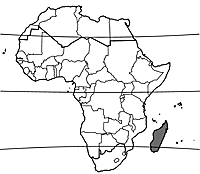Beguea apetala (PROTA)
Introduction |
Beguea apetala Capuron
- Protologue: Mém. Mus. natl. Hist. nat., sér. B, Bot. 19: 105 (1969).
- Family: Sapindaceae
Origin and geographic distribution
Beguea apetala is endemic to Madagascar, where it is found in the northern and eastern parts of the island.
Uses
The wood of Beguea apetala is primarily used for boat building, as is the case for several other Sapindaceae species.
Description
- Dioecious medium-sized tree up to 25 m tall; bole up to 50 cm in diameter; young twigs yellowish brown to reddish brown hairy, soon becoming glabrous.
- Leaves alternate, paripinnately compound with 3–7 pairs of leaflets; stipules absent; petiole 2.5–7 cm long, rachis 3–17 cm long; petiolules 2–5 mm long; leaflets opposite to alternate, elliptical to lanceolate, 3–16 cm × 1.5–4.5 cm, cuneate at base, usually acuminate at apex, margins entire, glabrous, pinnately veined with many lateral veins.
- Inflorescence a slender, axillary raceme up to 25 cm long, densely short-hairy.
- Flowers unisexual, regular; pedicel 2–5 mm long; calyx 1.5–3 mm in diameter, with 5–8 short lobes, short-hairy outside; petals absent; stamens 6–8, up to 8.5 mm long, filaments pink, anthers purple; disk thick, cushion-shaped; ovary superior, c. 2 mm long, 3-celled, style c. 2.5 mm long; male flowers with rudimentary ovary, female flowers with reduced stamens.
- Fruit a globose to obovoid berry up to 2 cm long, indehiscent, 1-seeded.
- Seed globose to obovoid, c. 12 mm long, brown, enclosed by fleshy, translucent aril.
Other botanical information
Beguea comprises about 7 species and is endemic to Madagascar.
Ecology
Beguea apetala occurs in sub-humid and humid evergreen forest from sea-level up to 1000 m altitude.
Genetic resources
Beguea apetala is fairly widespread and there are no indications that it is threatened, but monitoring its populations will be meaningful in view of the reduction of natural forest areas in eastern Madagascar.
Prospects
As is the case for other Sapindaceae species with similar use and wood quality, proper management of populations of Beguea apetala is needed to ensure sustainable use, but data are lacking to do adequate recommendations.
Major references
- Boiteau, P., Boiteau, M. & Allorge-Boiteau, L., 1999. Dictionnaire des noms malgaches de végétaux. 4 Volumes + Index des noms scientifiques avec leurs équivalents malgaches. Editions Alzieu, Grenoble, France.
- Capuron, R., 1969. Révision des Sapindacées de Madagascar et des Comores. Mémoires du Muséum National d’Histoire Naturelle, Nouvelle série, Série B, Botanique 19: 1–189.
- Schatz, G.E., 2001. Generic tree flora of Madagascar. Royal Botanic Gardens, Kew, Richmond, United Kingdom. 477 pp.
Other references
- Buerki, S., Forest, F., Acevedo-Rodriguez, P., Callmander, M.W., Nylander, J.A.A., Harrington, M., Sanmartin, I., Kupfer, P. & Alvarez, N., 2009. Plastid and nuclear DNA markers reveal intricate relationships at subfamilial and tribal levels in the soapberry family (Sapindaceae). Molecular Phylogenetics and Evolution 51(2): 238–258.
- Buerki, S., Lowry II, P.P., Phillipson, P.B. & Callmander, M.W., 2010. Molecular phylogenetic and morphological evidence supports recognition of Gereaua, a new endemic genus of Sapindaceae from Madagascar. Systematic Botany 35(1): 172–180.
- TransMad, 2004. La filière de construction de goélettes des chantiers navals de Belo sur mer et les problématiques d’approvisionnement en matière première. [Internet] http://www.transmad.org/ news/38/46/ Le-rapport-de-synthese-bibliographique.html. May 2010.
Author(s)
- C.H. Bosch, PROTA Network Office Europe, Wageningen University, P.O. Box 341, 6700 AH Wageningen, Netherlands
Correct citation of this article
Bosch, C.H., 2011. Beguea apetala Capuron. [Internet] Record from PROTA4U. Lemmens, R.H.M.J., Louppe, D. & Oteng-Amoako, A.A. (Editors). PROTA (Plant Resources of Tropical Africa / Ressources végétales de l’Afrique tropicale), Wageningen, Netherlands. <http://www.prota4u.org/search.asp>.
Accessed 18 December 2024.
- See the Prota4U database.

